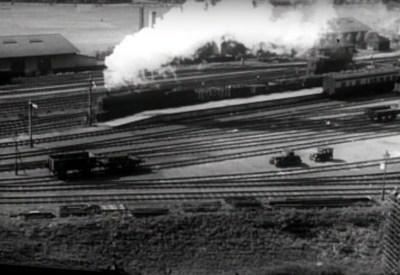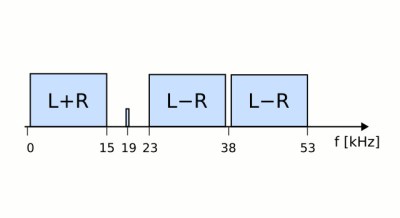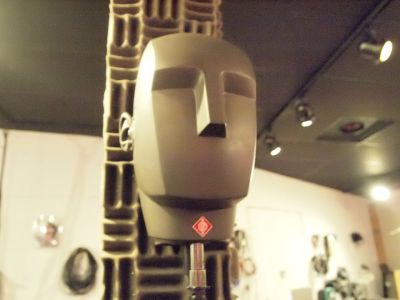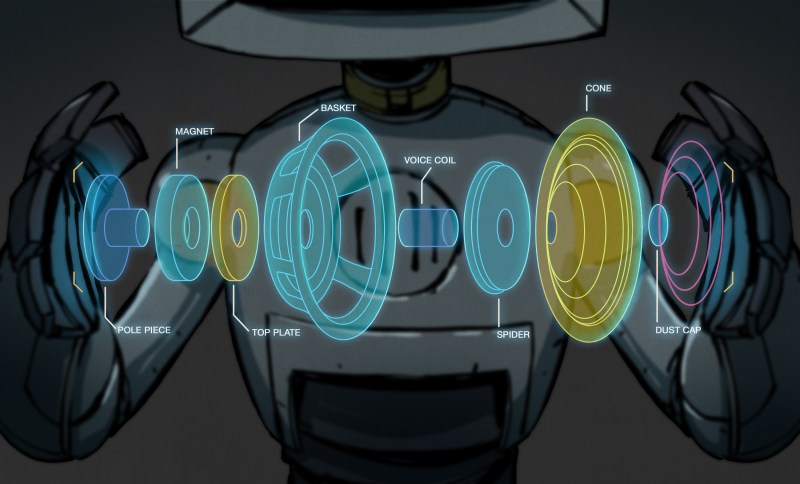In our occasional series charting audio and Hi-Fi technology we have passed at a technical level the main components of a home audio set-up. In our last outing when we looked at cabling we left you with a promise of covering instrumentation, but now it’s time instead for a short digression into another topic: stereo. It’s a word so tied-in with Hi-Fi that “a stereo” is an alternative word for almost any music system, but what does it really mean? What makes a stereo recording, and how does it arrive at your ears?
From West London Trains, To 3D Audio

As most of you will know, a mono recording uses a single microphone and a single channel while a stereo one uses two microphones recording simultaneously a left and right channel. These are then played back through a pair of speakers, and the result is a sense of spatial field for the listener. Instruments appear to come from their relative positions when recorded, and the sense of being in the performance is enhanced.
Stereo recording as we know it was first perfected as one of the many inventions credited to Alan Blumlein, then working for EMI in London. We have one of his stereo demonstration films in “Trains at Hayes“, filmed from the EMI laboratories overlooking the Great Western Railway, and featuring a series of steam-hauled trains crossing the field of view with a corresponding stereo sound field. His work laid down the fundamentals of stereo recording, including microphone configurations and what would become the standard for stereo audio recording on disk with the channels on the opposite sides of a 45 degree groove.
More Than Just A Mix
On the face of it, a stereo recording delivers only left-right positional information, and thus can be created from a series of mono tracks by adjusting their position in the stereo mix. For example, a band could have the bass guitar placed mostly in the left channel and the lead guitar in the right, with the drummer and vocalist equally in both channels to place them in the centre. Listen to “Yellow Submarine” fully panned.
In the modern era, a true stereo recording picks up much more than the relative intensities of different sounds, it records the complex web of timing and phase differences in the sound including those in the background noise. Thus a stereo recording created from a mix of mono recordings can best be referred to as pseudo-stereo because it lacks that phase information which gives the stereo recording so much depth.
In an analogue tape deck or a vinyl record the stereo channels are recorded separately as tape tracks or opposite sides of the groove. Meanwhile in digital audio systems the left and right channels arrive as bitstreams either from an interleaved i2S source such as a CD player, or from a decompression algorithm in for example an MP3 player or internet streaming software. There is however one place in which you’ll still commonly encounter a stereo source that uses an analogue encoding system, namely FM radio. This features a system in which the main broadcast is in mono, but the stereo information is separately encoded on the transmission at an inaudible frequency for decoding in the receiver.
The Last Bastion Of Analogue Stereo

For the purposes of FM broadcasting, the left and right channels are combined into sum, or L+R that represents the mono component, and a difference between the channels, or L-R. These are quickly generated using a straightforward op-amp circuit. The L+R is modulated as the audio you hear on a mono receiver, while the L-R is encoded separately as a 38 kHz double sideband signal out of the audio range. A 19 khz pilot tone is added between the audio band and the stereo information, and in the demodulator this is used with a frequency doubler to provide a 38 kHz tone to demodulate the L-R difference component. This is then added and subtracted from the mono signal to rebuild the left and right channels. This system originated in a Zenith proposal from the early 1960s, and remains in use worldwide today.
There are a huge variety of signal processing techniques to enhance the stereo experience or produce stereo effects. Just one example is Dolby Atmos, and you will hear them at work in many computer games and films. All this digital magic is not the only way to play with stereo though, a favourite 1970s project was a stereo expander. These devices worked by subtracting a small amount of the left from the right and vice versa, having the effect of reducing the proportion of L+R and increasing the proportion of L-R in the output. In these days of cheap DSP, some professional audio is moving toward the similar Mid/Side encoding.
Binaural, It’s All In The Ears

There’s one final piece to the stereo puzzle, which you might have noticed if you’ve ever encountered a recording described as “binaural”. A stereo recording is generally intended to be played to the listener using a pair of speakers, in an ideal situation where the speakers and the listeners head form the points of an equilateral triangle. In this way each ear hears something of both left and right, with whichever side the ear is closest to being the dominant of the two.
In a binaural recording each channel is intended only for one ear, so it is designed to be listened to on a pair of headphones. Binaural recordings are often made with microphones designed to replicate the acoustic characteristics of a human head with microphones placed in its ear canals, with the intention of producing the illusion of a real-world directional audio field. YouTube is full of examples, and we’ve picked this traversal of central London to give you an idea.
So whether you’re an audio enthusiast or are satisfied with the cheapest of dollar-store speakers, we hope you’ve enjoyed our high-fidelity journey into the world of two-channel audio. Stay tuned for more, as we’ll return with another in this Know Audio series.
















Did I miss the part where they talk about the shape of the ear and how it’s integral to hearing the positioning of the source?
It’s assumed that the majority of listeners have ears, including the requisite outer bits. ;-) The pinnae (outer ears) primarily enhance the detection of height and front/back info.
One factor not often mentioned is that the listener is continually making small head movements, which increases our ability to determine a sound’s source.
You humans ALWAYS do this! You ALWAYS assume other humans are reading your messages!
Seriously, it’s very frustrating.
Apologies for my humanist assumption. But your species must have ‘ears’, and at least two, otherwise stereo would be a foreign concept on your homeword, amirite?
Binaural since 1881. The original VR for sound. Clement Ader’s doing before he got airborne with no help but probably only good for Flugtag. His story is worthy of a HaD article.
I’ve been recording live events this way since ’80 or so, spaced omni’s 10 years earlier. You are right on multi mono mixes which is 99% of all recordings made. They are not stereo which means solid as seen in pictures in 3D. Phil Specter at least went beyond the “tri-phonic” mix that came from 3 track tape. Hole-in-the-middle “stereo” and the vocals in mono. Hollywood standard mix to this day. Wall of sound vs. wall is not there and there is a virtual hole in space-time.
check the Soundman in ear microphones. they deliver a very immersive sound.
When I was but a wee teenager we were at a family party and the stereo was on. It was one of those early 80’s assault stereos, you know, the all black with big speakers kind. My dad tells me to go adjust the the balance because there is a lone guitarist in the corner of the room. I looked at the stereo and the balance was in the center. I then told dad “It’s in stereo.” Dad went to adjust the stereo when my uncle told him not to touch it. Dad complains about the guitarist and the uncle reponds “It’s in stereo.”
Most audio is mixed assuming speaker listening. I’m guessing most listeners now, though, use headphones. Ages ago I bought a crossfeed headphone amplifier that fixed the nauseating feeling of listening to harsh stereo mixes through headphones. You can (and should!) build one yourself (look up the Cmoy designs) and try it out. Other random note, I thought one of those acoustic dummy heads would be a cool way to display a pair of high end headphones. Then found out the were several thousand dollars.
I dunno that most listening is done through headphones, but certainly there’s more of that now than 20+ years ago.
Styrofoam wig stands make great headphone holders. Paint’em up, 3-D print some features like ears, brow, nose… a Kunstkopf look without the price.
(and yes, binaural recording is awesome and fairly easy to do. Stick some decent omni electrets in a set of open Walkman-style headphones… instant stealth binaural rig)
Fascinating.🖖
Reminds me of the old Sennheiser Dummy Head Recording LP!
English:
https://www.youtube.com/watch?v=wbIKKc8zcOA
German:
https://www.youtube.com/watch?v=mvzv2EE7-V4
LP records are mono under abt 200 hz
No directionality at low frequencies. It’s the same reason you only need one subwoofer.
If you want to view the signal with 19 and 38 kHz subcarriers in a modern radio, usually you have to find the main integrated circuit and read in it’s datasheed which pin is DET OUT or MPX IN. I found it in my old radio, soldered wires to get that signal outside the case and I’m trying to build an RDS decoder (another subcarrier, 57 kHz), but without a dedicated IC, only with general purpose components (i.e. LC filters, transistors or op-amps etc.). Of course there will still be some AVR to process the demodulated data. Not many people have tried this, I found only some on this forum: https://www.mikrocontroller.net/topic/319718 And about an old FM stereo demodulator: https://www.keith-snook.info/quad-fm1-stereo-mpx-decoder.html
I made a bunch of binaural recordings on minidisc back in the early 2000s. I put electret capsules in my ears to make the recordings, many in Japan, some in my back yard in rural Missouri. You can hear them here:
https://drmrehorst.blogspot.com/2018/10/binaural-recordings.html
Actually, part of the article is wrong. Just because mono uses a single channel and output source, doesn’t mean it HAS to use one microphone. Actually, common practice in music and high grade sound over mono was achieved by using a plethora of different mikes positioned and mixed together with the mikes at different levels to get the best sound possible on mono. In some comparisons, the mono setup in this fashion sometimes produced better sound output on a single speaker, than stereo does with two. Of course, if you are using headphones, you get separation that is not possible with mono, and few audiophiles would want to give up stereo headphones (2 channels: if they have more channels they are not stereo, they are quadraphonic [4 channels] or a dotted notation like 5.1 or 7.1). I have a headset that came with my cell phone that is either quad or higher. Of course, you only have two ears, and surround sound was designed with spatial orientation and a mix of speakers used (first number 5, is the total number of speakers, including the bass which is what the .1 stands for. I wish I could remember the source of this information but I think it was a streaming documentary on a major service (netflix, prime, I don’t remember which).
Stereo is an odd idea, in its purist form, binaural is quite faithful, otherwise it’s a strange construct but interesting aurally. In film we watch a 2d image that cuts from wide shots to close ups and changes in camera angles and positions to show points of view, stereo or surround sound is a strange construct in this film space.